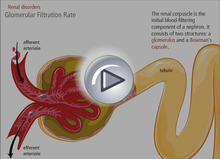Gemini Tanna, MD, FRCPC, Division of Nephrology, Sunnybrook Health Sciences Centre, University of Toronto, Toronto, Ontario, Canada
Sarbjit Vanita Jassal, MB, BCh, MD, Division of Nephrology, University Health Network, University of Toronto, Toronto, Ontario, Canada

This article includes web exclusive content. Once you have logged in, you will be able to access the full text of the artilcle, an online animation, and a "Test Your Knowledge" quiz.
 Chronic kidney disease (CKD) is increasingly common among older adults. In the older individual, the presence of CKD is predictive of cardiovascular death, increased all- cause mortality, and progression to end-stage renal disease and the need for dialysis. Early identification of these high-risk individuals may prevent or delay such adverse outcomes. The Canadian Society of Nephrology (CSN) released a position statement in September 2006 suggesting that screening be limited to those at high risk. We recommend that clinicians follow the CSN algorithm for screening for CKD among older adults.
Chronic kidney disease (CKD) is increasingly common among older adults. In the older individual, the presence of CKD is predictive of cardiovascular death, increased all- cause mortality, and progression to end-stage renal disease and the need for dialysis. Early identification of these high-risk individuals may prevent or delay such adverse outcomes. The Canadian Society of Nephrology (CSN) released a position statement in September 2006 suggesting that screening be limited to those at high risk. We recommend that clinicians follow the CSN algorithm for screening for CKD among older adults.
Key words: chronic kidney disease, estimated glomerular filtration rate, older adults, renal function, screening.


 Chronic kidney disease (CKD) is increasingly common among older adults. In the older individual, the presence of CKD is predictive of cardiovascular death, increased all- cause mortality, and progression to end-stage renal disease and the need for dialysis. Early identification of these high-risk individuals may prevent or delay such adverse outcomes. The Canadian Society of Nephrology (CSN) released a position statement in September 2006 suggesting that screening be limited to those at high risk. We recommend that clinicians follow the CSN algorithm for screening for CKD among older adults.
Chronic kidney disease (CKD) is increasingly common among older adults. In the older individual, the presence of CKD is predictive of cardiovascular death, increased all- cause mortality, and progression to end-stage renal disease and the need for dialysis. Early identification of these high-risk individuals may prevent or delay such adverse outcomes. The Canadian Society of Nephrology (CSN) released a position statement in September 2006 suggesting that screening be limited to those at high risk. We recommend that clinicians follow the CSN algorithm for screening for CKD among older adults.